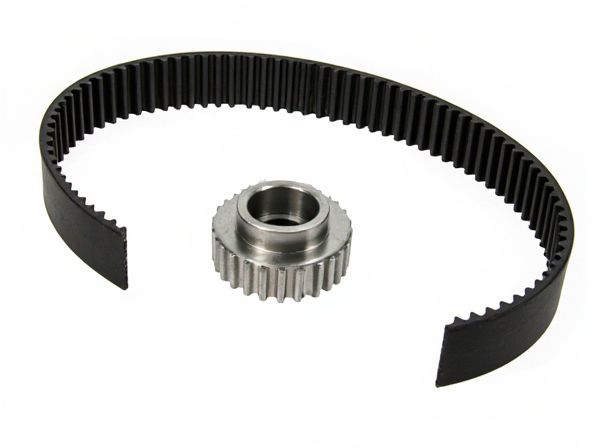
Photo illustration: Timing Belt Kit vs Standalone Timing Belt
Choosing a timing belt kit over a standalone timing belt ensures you receive all necessary components like tensioners, pulleys, and seals for a comprehensive replacement, reducing the risk of future failures. A complete kit enhances engine reliability and saves you time and money by preventing multiple repairs. Your vehicle benefits from synchronized performance and extended belt life when all parts are replaced simultaneously.
Table of Comparison
| Feature | Timing Belt Kit | Standalone Timing Belt |
|---|---|---|
| Components Included | Timing belt, tensioners, pulleys, seals | Only the timing belt |
| Cost | Higher initial cost | Lower initial cost |
| Installation Time | Longer, due to multiple parts | Shorter, belt only |
| Maintenance | Comprehensive, all parts replaced | Limited, belt only |
| Durability | Improved, reduces risk of secondary failures | Dependent on belt condition only |
| Recommended Use | Full engine timing service | Timing belt replacement only |
Introduction to Timing Belts and Timing Belt Kits
Timing belts are essential components in internal combustion engines, synchronizing the rotation of the crankshaft and camshaft to ensure precise valve timing. A standalone timing belt offers the core function of timing regulation, but a timing belt kit includes complementary parts such as tensioners, pulleys, and sometimes water pumps, providing a comprehensive solution for reliable engine performance. Using a timing belt kit reduces the risk of premature wear and failure by replacing all related components simultaneously, ensuring optimal durability and maintenance efficiency.
Components: What’s Included in a Timing Belt Kit?
A timing belt kit typically includes the timing belt itself, tensioners, idler pulleys, and sometimes the water pump, providing a comprehensive solution for engine timing maintenance. Standalone timing belts only replace the belt without additional components, which may lead to quicker wear on adjacent parts. Using a full timing belt kit ensures synchronized replacement, reducing the risk of mechanical failure and enhancing engine longevity.
Standalone Timing Belt: Definition and Use Cases
A standalone timing belt is a single component designed to synchronize the rotation of the crankshaft and camshaft in internal combustion engines, ensuring precise valve timing. It is a cost-effective option suitable for vehicles requiring a simple replacement without the need to change associated parts like tensioners or pulleys. Ideal for routine maintenance when the other components remain in good condition, standalone timing belts offer a focused repair solution while maintaining engine performance and reliability.
Cost Comparison: Kit vs Standalone Belt
A Timing Belt Kit, which includes the belt, tensioners, and pulleys, typically costs more upfront than a standalone timing belt but provides better overall value by reducing future repair expenses and labor costs. Replacing a standalone timing belt alone might appear cheaper initially but risks additional costs if tensioners or pulleys fail soon after. Investing in a kit enhances reliability and longevity, often lowering total maintenance costs over the engine's life.
Installation Complexity and Labor Considerations
Timing belt kits include the belt, tensioners, and pulleys, simplifying installation by providing all necessary components and reducing the risk of future failures due to worn parts. Standalone timing belts require separate inspection or replacement of related components, potentially increasing labor time and costs if those parts fail later. Mechanics often recommend kits for comprehensive service, minimizing the likelihood of multiple labor sessions and ensuring optimal engine timing function.
Durability and Maintenance Intervals
Timing belt kits typically include the timing belt, tensioner, and idler pulleys, offering improved durability and consistent performance compared to a standalone timing belt. The integrated components in timing belt kits reduce wear and maintenance frequency, often extending service intervals beyond 60,000 to 100,000 miles depending on the vehicle manufacturer's recommendations. In contrast, replacing only the standalone timing belt may lead to premature failure of related parts, increasing overall maintenance costs and risking engine damage.
Reliability and Potential Failure Points
Timing belt kits, which include a timing belt, tensioners, idler pulleys, and water pump, offer enhanced reliability by replacing all components susceptible to wear simultaneously, reducing the risk of failure from secondary part degradation. Standalone timing belts, while initially cheaper, pose higher potential failure risks due to neglected associated components like tensioners that can seize or fail, leading to belt damage and engine timing issues. Comprehensive replacement through a kit ensures synchronized performance and minimizes costly engine repairs caused by timing belt failure.
Warranty and Manufacturer Recommendations
Timing belt kits typically include the timing belt, tensioners, and water pump, offering a comprehensive replacement with a warranty that often exceeds standalone belts due to the inclusion of multiple components. Manufacturers recommend timing belt kits over standalone belts to ensure optimal performance and longevity, as they address all related wear parts simultaneously. Choosing a kit aligns with warranty conditions and reduces the risk of premature failure, providing better protection for the engine.
Vehicle Compatibility and Application Scenarios
Timing belt kits offer a comprehensive solution by including the belt, tensioners, and idler pulleys, ensuring coordinated wear and optimal performance for specific vehicle models such as Honda Accord, Toyota Camry, and Ford F-150. Standalone timing belts suit budget-conscious repairs or minor maintenance on vehicles with known component longevity, commonly used in older or low-mileage cars like the Mazda 3 or Subaru Impreza. Kits are recommended for high-mileage or high-stress applications to prevent future failures, while standalone belts fit simpler, less demanding scenarios where other parts remain in good condition.
Making the Right Choice: Timing Belt Kit or Standalone Belt?
Choosing between a timing belt kit and a standalone timing belt depends on the vehicle's maintenance history and overall condition. Timing belt kits include complementary components such as tensioners, idler pulleys, and water pumps, offering a comprehensive solution that reduces the risk of future failures and extends engine longevity. Opting for a kit ensures synchronized performance and cost efficiency compared to replacing individual parts separately.
 caratoz.com
caratoz.com